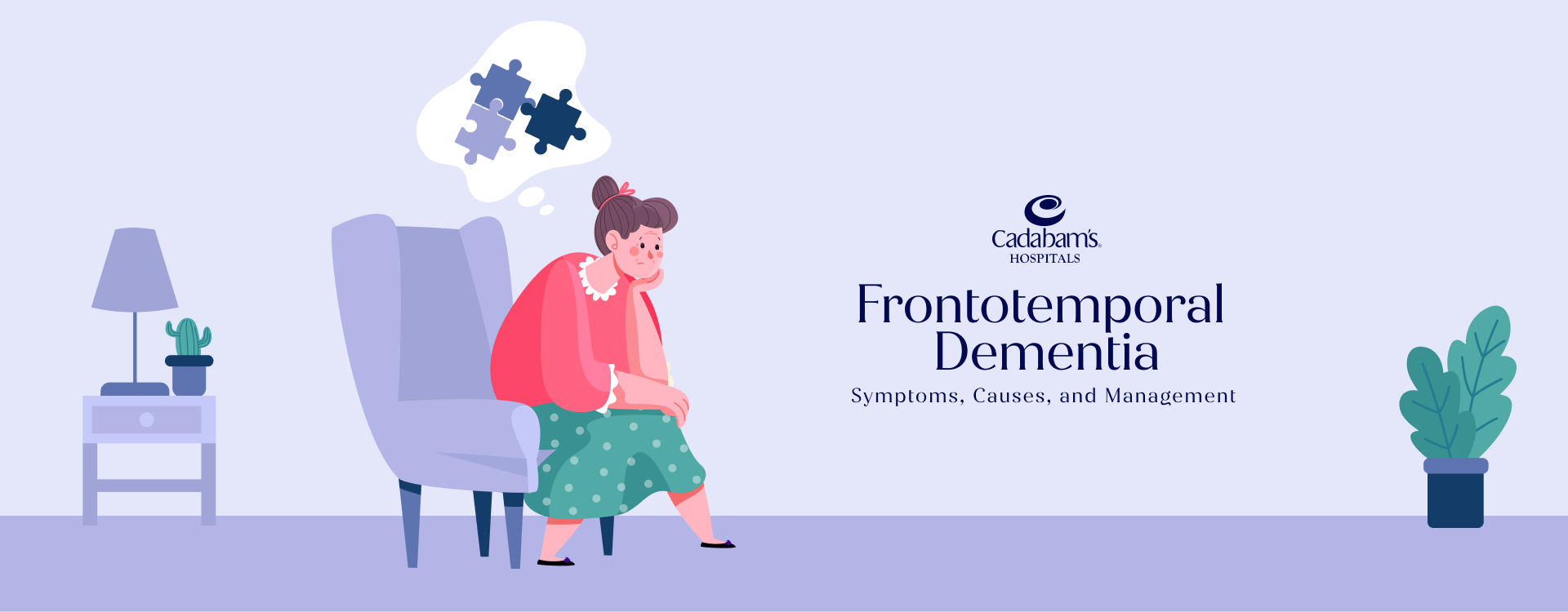Table of Content
Frontotemporal dementia is not a familiar name for many, but it needs to be widespread. It affects the area of the brain that is associated with personality, behavior, and language. In this type of dementia, the frontal and temporal lobes shrinks, known as atrophy. Unlike other forms of dementia, it occurs at a young age between 40-65, although it may affect people later in life.
What is Frontotemporal Dementia (FTD)?
FTD dementia is an umbrella term for various brain diseases that harm the frontal and temporal lobes of the brain. The symptoms start at young ages, between 40-65, which makes them socially inappropriate, impulsive, or emotionally indifferent. They also cannot use proper language. 10% to 20% of the time, FTD becomes the cause of dementia.
Types of FTD
Frontotemporal Dementia (FTD) is a complex disorder, characterized by a group of brain disorders affecting personality, behavior, and language. It's divided into several types, each with unique symptoms and challenges.
Frontal:
This is the most common form of FTD, which causes changes in personality and behavior. Individuals face problems with cognition: the symptoms include the inability to sequence tasks properly, repetition of activities or words, impulsivity, and isolation.
Primary progressive aphasia (PPA):
This form of FTD affects communication ability; it affects how a person uses language to speak, read, write, and understand others. People face difficulty understanding and speaking properly. PPA is characterized as semantic, agrammatic, and logopenic.
Movement disorders:
Corticobasal syndrome and progressive supranuclear palsy are two rare neurological movement disorders related to FTD that occur when the brain region that controls movement gets affected.
Differences Between FTD and Other Dementias
Dementia is a broad term that describes a variety of conditions characterized by cognitive decline, affecting memory, thinking, and social abilities severely enough to interfere with daily functioning. Among these conditions, Frontotemporal Dementia (FTD) and other types of dementia like Alzheimer's disease and Vascular dementia are notable. While they all fall under the umbrella of dementia, there are significant differences in their symptoms, affected brain areas, and the age at which they typically begin. Understanding these differences is crucial for diagnosis, management, and providing appropriate care.
Frontotemporal Dementia (FTD)
- Affected Areas: Primarily impacts the frontal and temporal lobes of the brain.
- Symptoms:
- Behavioral changes, including personality alterations and social inappropriateness.
- Language difficulties, such as problems with speaking, understanding, reading, or writing.
- Memory problems may occur, but they are not as prominent in the early stages.
- Onset Age: Typically starts at a younger age, often between 45 and 65 years.
Other Dementias (e.g., Alzheimer's Disease, Vascular Dementia)
- Affected Areas: Commonly affect the hippocampus and parietal lobes, crucial for memory and spatial awareness.
- Symptoms:
- Memory loss, particularly short-term memory, is a hallmark symptom.
- Spatial disorientation, including difficulty navigating familiar environments.
- In later stages, may also include language difficulties and behavioral changes, but these are not usually the initial symptoms.
- Onset Age: Generally occur at a later age, usually after 65 years.
Signs and Symptoms of Frontotemporal Dementia
Signs of frontotemporal dementia differ from person to person and occur in clusters. Individuals may have more than one cluster of symptoms. These symptoms get worse over the years.
Behavioral Changes of Frontotemporal Dementia
The most significant and noticeable symptom of FTD is extreme changes in behavior and personality. Individuals start behaving inappropriately in social situations and show a lack of interest in activities. They lose interpersonal skills, like behaving insensitively towards others' feelings. They lack a sense of judgment and lose inhibitions. Compulsive behaviors start surfacing, like tapping, clapping, or lip-smacking and putting unnecessary things in the mouth. Their eating habits change, like overeating or weakness towards sweets and carbohydrates.
Language and Communication Impairments of Frontotemporal Dementia
Certain subtypes of frontotemporal dementia, like semantic dementia and progressive agrammatic aphasia, lead to loss of speech and changes in language ability. Individuals experience trouble understanding and using written and spoken language, which makes them unable to find and use the right words. They replace words with "it," "this," "that," etc., and face trouble naming things. Forgetting the meaning of words and then using two-word sentences to talk. Falling short of words makes it difficult for them to build the right sentences.
Physical Symptoms and Progression of Frontotemporal Dementia
Certain subtypes of FTD lead to movement disorders very similar to Parkinson’s disease. Individuals experience various physical difficulties, like troubled walking and poor coordination of body movements. They may get mild to severe tremors and face rigidity in the body. Muscle spasms and twitches are common occurrences. Their muscles also get weak, which affects the coordination of body parts. Sometimes, they even have trouble swallowing food.
Causes and Risk Factors for FTD
Abnormal protein build-up in the frontal and temporal lobes damages brain cells and stops them from working properly. These brain regions control language, behavior, and judgment skills in an individual, which are affected by the condition. There is no absolute reason that leads to FTD, but there are some genetic links, such as the fact that people who have relatives with dementia are more likely to develop the condition. Various studies are ongoing to understand the actual causes and treatments of FTD.
Diagnosing Frontotemporal Dementia
Diagnosing FTD can be hard as the symptoms overlap with various other conditions. Multiple tests can be done to diagnose the illness and rule out other possible causes of the symptoms.
Medical Tests and Assessments
Frontotemporal dementia requires multiple tests and assessments to conclude the diagnosis, as it is difficult to provide an accurate result. Medical professionals will suggest routine blood tests and physical examinations to exclude other conditions with similar symptoms.
Blood Tests
Currently, blood tests cannot diagnose frontotemporal dementia, but they may help in ruling out possible causes of dementia or supporting causes of FTD. These tests rule out other medical conditions that may have similar symptoms to dementia, like thyroid and vitamin deficiencies.
Sleep Study
Obstructive sleep apnea has some similar symptoms to frontotemporal dementia, which include changes in memory, thinking, and behavior. A sleep study is needed if there are problems like loud snoring and pauses in breathing while sleeping, and the study will help rule out if the symptoms relate to obstructive sleep apnea.
Brain Function Tests
These tests include various assessments to test an individual's reasoning and memory skills. They are very helpful in determining which type of dementia the person might have at a very early stage and help differentiate FTD from other forms of dementia.
Brain Scans
Brain scans can identify the causes of the symptoms, which may include clots, bleeding, or tumors. With magnetic resonance imaging, the shape and size of the frontal and temporal lobes are revealed. FDG-PET scans highlight those parts of the brain where nutrients are poorly metabolized, which can help diagnose the type of dementia.
Challenges in Diagnosis
- FTD has various symptoms, unlike other dementias, which can be easily mistaken for other mental health conditions like depression, anxiety, or bipolar disorder.
- Neurological and psychiatric conditions have similar symptoms to FTD, which can complicate the diagnostic process.
- The illness doesn’t have a definitive biomarker, which makes the diagnosis rely on clinical evaluation and sometimes with ruling out process.
- Cognitive tests may not be as sensitive to capture FTD-related impairments.
- Brain imaging helps rule out other conditions, but it can’t diagnose FTD in all cases.
Treatment Options and Management for Frontotemporal Dementia
FTD treatment doesn’t cure or slow down the progression, but it does help manage the symptoms of the illness. Research is ongoing to find a solid treatment that can cure the illness. Individuals can benefit from medications like antidepressants and antipsychotics. Therapies like behavior modification and speech therapy help manage risky behaviors and daily activities.
Medications and Therapies
Frontotemporal dementia can be helped with medications and therapies. Medications help to control behavioral problems, while therapies help manage problems with movements and everyday communication. Dementia activities and support groups are also beneficial.
Antidepressants
Antidepressants don’t treat the underlying cause of FTD, but they help manage behavioral symptoms like anxiety, depression, impulsivity, and repetitive behaviors, which can be troublesome. Antidepressants make a lot of difference as they control these behaviors.
Antipsychotics
Antipsychotics are not the ideal treatment for frontotemporal dementia and should be given as a last resort when other treatments fail to manage the behavioral symptoms that can be risky. These can temporarily reduce some symptoms, but their long-term effectiveness is weak.
Speech Therapy
FTD is a progressive illness that affects the communication of an individual. This therapy helps by focusing more on communication skills and maintaining quality of life. Individuals learn various strategies to manage social interactions and improve verbal communication.
Supportive Care and Lifestyle Adjustments
A few supportive care and adjustments can help reduce risk and manage FTD symptoms. Installing effective communication strategies like speech therapy, using simple language, and visual aids can help people communicate better. Maintaining a structured routine with predictable activities can reduce anxiety and provide comfort. Install a few safety measures, like bars, lights, and locking dangerous objects, which will prevent various hazards. Adapting calming strategies like music therapy, nature walks, or gentle massage can manage potential outbursts. Adopt a healthy lifestyle with regular exercise, a nutritious diet, and sleep hygiene.
Living with Frontotemporal Dementia
Frontotemporal dementia symptoms like inappropriate behavior, emotional problems, and communication troubles can make it difficult for an individual to lead an everyday life. However, starting an FTD-specific treatment and learning specific coping mechanisms can help with daily living.
Coping Strategies for Patients and Caregivers
For patients:
Start by maintaining a structured routine with familiar activities, which will reduce anxiety. Participate in activities that are enjoyable and align with their interests. Try art therapy and music therapy, which will release complex emotions and provide a form of communication. Practicing relaxation techniques and regular physical activity also helps.
For caregivers:
To provide care to an individual with FTD, there needs to be a certain level of understanding of the illness and its progression, which will also help the caregiver make informed decisions. Seek external support, like therapies or support groups, to alleviate some of the burden of caregiving. Practice relaxation techniques to manage stress; set boundaries to ensure self-care.
Resources and Support Networks
For resources and support networks, various organizations offer help to patients and caregivers. There are counseling and support groups that can provide emotional support and guidance for the patient as well as the caregiver. Engaging in social activities can stimulate cognitive functions and maintain social interactions. Preparing a future care plan can be helpful to ensure both patient's and caregivers' wishes are respected.
FTD Treatment and Care with Cadabams Hospitals
Battling with frontotemporal dementia can be difficult; you need the right support to manage its symptoms. Cadabams is a prominent name in the mental healthcare sector, and with over 30 years of experience, we offer the best mental healthcare professionals. We leverage evidence-based approaches and holistic treatment methods to help individuals effectively manage the symptoms of FTD. Get in touch with us today. You can call us at +91 97414 76476. You can even email us at info@cadabamshospitals.com.
FAQ
1. What is the best treatment for frontotemporal dementia?
The illness doesn’t have one treatment but multiple approaches that focus on managing symptoms and improving quality of life. Medications like antidepressants and antipsychotics help manage disruptive behaviors. Speech and occupational therapy is used to address problems with daily activities and communication. Physical therapy helps with movement problems.
2. Is there a way to prevent FTD?
There is no scientifically proven way to prevent FTD, but there are some protective measures that might lower the risk. Maintain a healthy lifestyle through regular exercise, healthy eating, and quality sleep. prevent any head injuries by using precautions while driving or doing adventures. Address any chronic health conditions to reduce the risk of dementia.
3. How long does frontotemporal dementia last?
FTD is a progressive disease, which means the symptoms get more severe over time, but the progression rate varies. The average life span after diagnosis is 6 to 8 years, but some live much longer. Age of onset also matters; young individuals live longer than older adults. Also, FTD doesn’t cause death, but the complications associated with it contribute to death.
4. What activities are good for patients with frontotemporal dementia?
Activities for individuals with FTD should be focused on enjoyment and social interaction. Make their interest a priority, which could include music, games, sports, etc. Focus on small, achievable goals, and choose activities that provide emotional and sensory stimulation. Encourage the individual to do regular physical activity—nothing intense but simple activities.
5. What is the main cause of frontotemporal dementia?
The exact cause of frontotemporal dementia is not understood, but it’s attributed to abnormal patient clump accumulation in the frontal and temporal lobes, which damages brain cells. These lobes control key functions like language, behavior, and planning. Genetics can be a risk factor. Research is going on that focuses on understanding the triggers for protein abnormality.
How Cadabam's Help you for Addiction?
- 410+ Professional Consultants
- 1,00,00+ Happy Faces
- 120+ Currently Seeking Treatments










